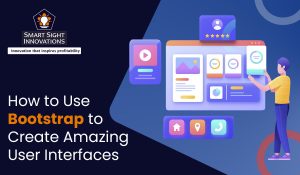 Bootstrap was created by a developer at Twitter in mid-2010 and has now become one of the most widely used open-source initiatives worldwide. The aim was to give a push to new CSS properties, decrease dependency and adopt new technologies across browsers. It was earlier known as Twitter Blueprint and is used as a reference manual for tool development.
Bootstrap was created by a developer at Twitter in mid-2010 and has now become one of the most widely used open-source initiatives worldwide. The aim was to give a push to new CSS properties, decrease dependency and adopt new technologies across browsers. It was earlier known as Twitter Blueprint and is used as a reference manual for tool development.
What Is Bootstrap?
Bootstrap is a free, open-source front-end development framework for building websites and web applications. It is used for creating websites that are mobile-first and responsive. It offers a variety of languages for template designs and has a vast collection of basic reusable codes written in HTML and CSS. It includes standard UI components like typograph, tables, forms, buttons, etc., and provides a reference manual for creating internal tools. Bootstrap 5 is the latest version.
Some examples of websites that were designed using Bootstrap are:
- Apple Maps Connect
- Lee
- Fox News
- Micromax
- Daniella Draper
- Reserve
- Apigee
- TimeBlend
Why Is Bootstrap Important?
Web designers and developers prefer Bootstrap because it is flexible and straightforward to use and comes with built-in support for jQuery plugins. Bootstrap is compatible with any editor and server-side technology and language, like ASP.NET, PHP and Ruby on Rails. Let us look at why web developers and designers love using Bootstrap.
- Bootstrap provides a built-in grid system, thus saving your time. It also includes a default icon library that might already be adequate for your website.
- You can rely on Bootstrap to resize or shape the images as it has its own codes for the same. You just need to add img-responsive (for resize) and img-circle or img-rounded (for shape) to the images and the preset CSS rules do the rest.
- Bootstrap includes a bunch of different components, like navigation bars, dropdowns, progress bars, thumbnails, etc., that can be added quickly to your website. These components give you a lot of pre-built functionality.
- Every code is clearly described and explained on the Bootstrap website. The explanations include basic applications and simple processes that a beginner can easily understand. You just need to select a component, copy and paste the code onto your page and continue.
- You can customize its size by choosing which functionality you want to include in the download. You need to uncheck the features you do not need and then download them, thus reducing the size of the file.
- Bootstrap has a large group of designers and developers who participate, give advice, interact and constantly modify and contribute to its codebase.
- Using Bootstrap spares you from creating a lot of CSS code. Many people make their own templates to quicken their web development process using Bootstrap.
- With Bootstrap, web developers can focus on the programming task without thinking about the design and quickly launch an attractive website. In addition, it provides a robust platform for creating exciting Bootstrap designs and themes.
Bootstrap Templates and Components
Basic HTML and CSS design templates with several regularly used UI components are part of the Bootstrap package. These templates are readily available and you can add this to your HTML and create different effects. The Bootstrap grid system is one of the major features of Bootstrap introduced in version 3. Grids give a layout structure to the content by setting horizontal and vertical rules and margins.
Bootstrap has several interactive components. Some of them are:
- Button group
- Dropdowns
- Navigation bar (Navbar)
- Carousel
- Popovers
- Badges
- Thumbnails
- Breadcrumb
- Collapse
- Modal
- Scrollspy
How To Create a User Interface (UI) Using Bootstrap?
The user interface (UI) of an app includes both its graphics and its functions. In an app, the UI designer is responsible for the colors that users see, the text they read, the buttons they click on, and the animations they interact with. You can create a user interface using Bootstrap by following the below steps:
- Before creating the UI, ensure you have the coding editor and a basic understanding of HTML and CSS.
- You then need to create a basic HTML file with the help of the code editor.
- Now make these HTML files into a Bootstrap Template. You must add the Bootstrap CSS and JS files using the content delivery network (CDN) links.
- Include the JavaScript files just before the closing tag. This will enhance the efficiency of your web pages.
- Once you add Bootstrap’s CSS and JS files, you can create any responsive website or application with the help of the Bootstrap framework.
Every day, whether it’s using a microwave, registering into an app or purchasing on an e-commerce site, we engage with user interfaces. Creating effective UI design leads to increased user satisfaction. Creating a feeling of familiarity and making sure that everything displayed on the screen makes sense and acts as the user would expect are key components of an exemplary user interface design.
You can develop an ideal UI by understanding and implementing the UI design principles such as simplicity, accessibility, consistency, user-centric features, and appropriate tools.











